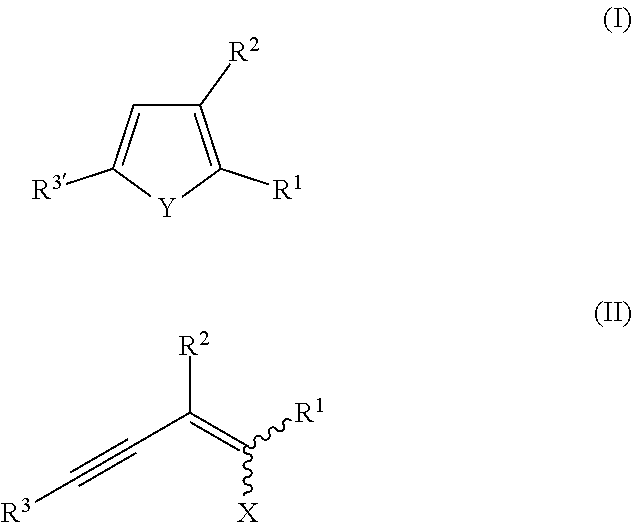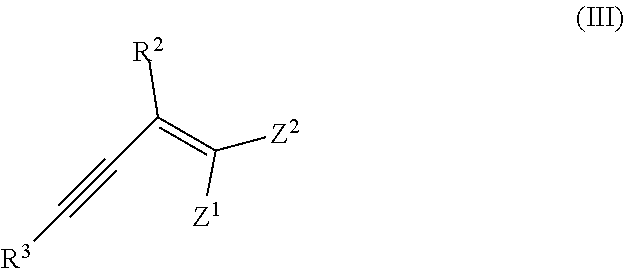Method for synthesis of chalcogenophenes
a chalcogenophene and functionalization technology, applied in the field of functionalization chalcogenophenes and their preparation, can solve the problems of low yield, low yield, and limited method to commercially available selenophenes, and achieve the effect of low-cost and effective methods
- Summary
- Abstract
- Description
- Claims
- Application Information
AI Technical Summary
Benefits of technology
Problems solved by technology
Method used
Image
Examples
example 1a
n of (3-(dibromomethylene)oct-1-yn-1-yl)trimethylsilane (II-1)
[0076]
[0077]Ethynyltrimethylsilane (0.01 mol, 1.0 equiv) was dissolved in dry tetrahydrofuran (20 mL) and the reaction mixture was cooled to 0° C. n-BuLi (2.5 M in hexanes, 0.011 mol, 1.1 equiv) was added dropwise to the solution. The reaction mixture was stirred for 30 min at ambient temperature. After cooling to 0° C., hexanal (0.01 mol, 1.0 equiv) was slowly added to the solution. The reaction mixture was allowed to warm to ambient temperature and stirred for additional 2 hours. The reaction was quenched with a saturated aqueous solution of ammonium chloride and was extracted three times with ethyl acetate (50 mL each). The combined organic phases were dried over magnesium sulfate and filtered. The solvent was removed under reduced pressure. The obtained propargylic alcohol (0.01 mol, 1.0 equiv) was slowly added to a suspension of pyridinium dichromate (0.011 mol, 1.1 equiv) and 4 Å molecular sieves (100% weight equiva...
examples 1b-1v
Compounds of Formula (II)
[0079]The compounds of formulae (II-2) to (II-22) indicated in table 2 below were obtained following the same protocol as indicated for compound (II-1) in Example 1A, by using the appropriate aldehydes and alkyne compounds as starting material. In all cases, the compounds were obtained in quantitative yield.
[0080]
TABLE 2Compounds of formula (II) prepared in Examples 1A to 1WCompound ofEntryformula (II)R2R3R1XExample 1AII-1 CSTMSBrBrExample 1BII-2 C7TMSBrBrExample 1CII-3 C7PhBrBrExample 1DII-4 PhTMSBrBrExample 1EII-5 PhPhBrBrExample 1FII-6 PhHBrBrExample 1GII-7 PhtBuBrBrExample 1HII-8 PhMePhBrBrExample 1III-9 Cl—PhTMSBrBrExample 1JII-10Cl—PhPhBrBrExample 1KII-11CF3—PhTMSBrBrExample 1LII-12CF3—PhPhBrBrExample 1MII-13Me—PhTMSBrBrExample 1NII-14Me—PhPhBrBrExample 1OII-15OMe—PhTMSBrBrExample 1PII-16OMe—PhPhBrBrExample 1QII-17FURTMSBrBrExample 1RII-18TPTMSBrBrExample 1SII-19Br—PhPhBrBrExample 1TII-20NAPTMSBrBrExample 1UII-21NAPPhBrBrExample 1VII-22NAPHBrBr
example 1b
n of (3-(dibromomethylene)dec-1-yn-1-yl)trimethylsilane (II-2)
[0081]Isolated as a pale yellow liquid quantitatively. 1H NMR (400 MHz, CDCl3): δ 2.29 (t, J=7.6 Hz, 2H), 1.58-1.50 (m, 2H), 1.29-1.24 (m, 8H), 0.87 (t, J=6.8 Hz, 3H), 0.19 (s, 9H). 13C NMR (100 MHz, CDCl3): δ 131.1, 103.1, 102.7, 97.5, 36.7, 31.7, 29.0, 28.8, 27.4, 22.6, 14.1, −0.3. HRMS-FI: Calculated 378.0008, Found 378.0062, Δ=14.18 ppm.
PUM
| Property | Measurement | Unit |
|---|---|---|
| dielectric constant | aaaaa | aaaaa |
| volume ratio | aaaaa | aaaaa |
| dielectric constant | aaaaa | aaaaa |
Abstract
Description
Claims
Application Information
 Login to View More
Login to View More - R&D
- Intellectual Property
- Life Sciences
- Materials
- Tech Scout
- Unparalleled Data Quality
- Higher Quality Content
- 60% Fewer Hallucinations
Browse by: Latest US Patents, China's latest patents, Technical Efficacy Thesaurus, Application Domain, Technology Topic, Popular Technical Reports.
© 2025 PatSnap. All rights reserved.Legal|Privacy policy|Modern Slavery Act Transparency Statement|Sitemap|About US| Contact US: help@patsnap.com



